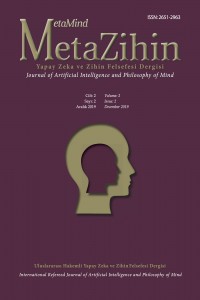Öz
Aristoteles’in canlılığın ilkesi ya da can anlamında ruhu [psykhê] temellendirdiği ve ağırlıklı olarak hayvan ruhu üzerinde durduğu eseri Ruh Üzerine’de hayvan ruhunu karakterize eden duyumsama mekanizması ayrıntılı olarak irdelenir. Buna göre duyumsama, duyulur cismin maddesiz biçimini bir ortam aracılığıyla almaktır. Burada biçimden kasıt, söz konusu duyuluru oluşturan öğelerin karışım oranıdır [logos]. Duyumsama hareketiyle duyu organı mütekabili olan duyulurdaki oranı alır, duyulura benzer hale gelir. “Duyum” [aisthêsis] bir orta olan duyu organının doğal oranıyla duyu organının dönüştüğü duyulurun oranı arasındaki farktır [diaphora]. Bu farkı ayıklamak [krinein] da duyuya düşer ve buna “algı” demek mümkündür. Kendine has mütekabilleri olan beş özel duyu vardır. Öte yandan, bazı duyulurlar bir duyuya özgü değildir, birden fazla duyu tarafından duyumsanabilirler. Bunlara “ortak duyulurlar” denir. Bunları “ortak olan” ya da “ortak duyu” [koinê aisthêsis] duyumsar. Ayrıca tek tek özel duyulurların mütekabillerinin birbirinden ayırılması da bu ortak duyuya düşer. Dahası, “bilinç” denebilecek olan “duyumsadığını duyumsama” da bu ortak duyunun işidir. Duyumların bir de kalıntıları vardır ki, bunları duyulur cisim erişim alanında olmadığında canlandıran yetiye “hayal gücü” [phantasia] denir. Hayal gücü bu kalıntıları canlandırarak bütün hayvanlara iştah [oreksis] ve insanlara akletme malzemesi olarak hayaller hazırlar. Bu iki ruh gücünün birbirinden ayrı şeyler olduğu düşünülegelmiştir. Ne var ki ortak duyu ve hayal gücü arasındaki ayrım göründüğü kadar keskin değildir.
Anahtar Kelimeler
Kaynakça
- Aristoteles. (2014). Fizik (çev. Saffet Babür). İstanbul: YKY.
- Aristoteles. (2018). Metafizik (çev. Y. Gurur Sev). İstanbul: Pinhan.
- Aristoteles. (2018). Ruh Üzerine (çev. Ömer Aygün - Y. Gurur Sev). İstanbul: Pinhan.
- Aristotle. (1957). On the Soul. Parva Naturalia. On Breath (tra. W. S. Hett). Massachusetts: Harvard University Press (Loeb Classical Library #526).
- Lefebvre, R. (1997). “La phantasia chez Aristote: subliminalité, indistinction et pathologie de la perception.” Les Études Philosophiques, 1; 41-58.
- Rahman, F. (1981). Avicenna’s Psychology. Connecticut: Hyperion.
- Ross, D. (1995). Aristotle. New York: Routledge.
- White, K. (2010). “The meaning of phantasia in Aristotle's De Anima, III, 3–8.” Dialogue 24(3); 483-505.
Öz
The mechanism of sensation is thoroughly examined in Aristotle’s work On the Soul where he grounds the soul as the principle of life and where he focuses especially on animal soul. Hereunder, sensing is receiving the form of the sensible body without its matter. Form, here, signifies the proportion [logos] of the mixture of elements that constitute the sensible. By the movement called sensing, sensory organ receives the proportion from the sensible, and becomes similar to it. Sensation [aisthêsis] is the difference between the natural proportion of the sensor and the proportion of the sensible that it receives and becomes. Discriminating [krinein] this difference belongs to the sense and may be called “perception.” There are five special senses that have their own kind of sensible objects. On the other hand, there are some sensibles like motion that can be sensed by more than one senses. They are called “common sensibles” and they are sensed by “something which is common” or “common sense” [koinê aisthêsis]. Also, distinguishing the exclusive objects of special senses belongs to the common sense. Again, sensing being sensing, i.e., consciousness is another duty of this common sense. There are the remnants of the sensations which are reanimated when the sensible is beyond the range of sensing. This process is carried out by imagination [phantasia]. By doing so, imagination prepares images as materials for the appetite of all animals and for the reasoning of human beings. It has been thought that these two are separate faculties of the soul. However, the schism between common sense and imagination is not that sharp as mentioned.
Anahtar Kelimeler
soul animal sensation common sense consciousness imagination
Kaynakça
- Aristoteles. (2014). Fizik (çev. Saffet Babür). İstanbul: YKY.
- Aristoteles. (2018). Metafizik (çev. Y. Gurur Sev). İstanbul: Pinhan.
- Aristoteles. (2018). Ruh Üzerine (çev. Ömer Aygün - Y. Gurur Sev). İstanbul: Pinhan.
- Aristotle. (1957). On the Soul. Parva Naturalia. On Breath (tra. W. S. Hett). Massachusetts: Harvard University Press (Loeb Classical Library #526).
- Lefebvre, R. (1997). “La phantasia chez Aristote: subliminalité, indistinction et pathologie de la perception.” Les Études Philosophiques, 1; 41-58.
- Rahman, F. (1981). Avicenna’s Psychology. Connecticut: Hyperion.
- Ross, D. (1995). Aristotle. New York: Routledge.
- White, K. (2010). “The meaning of phantasia in Aristotle's De Anima, III, 3–8.” Dialogue 24(3); 483-505.
Ayrıntılar
| Birincil Dil | Türkçe |
|---|---|
| Konular | Felsefe |
| Bölüm | Araştırma/İnceleme Makaleleri |
| Yazarlar | |
| Yayımlanma Tarihi | 30 Aralık 2019 |
| Kabul Tarihi | 28 Aralık 2019 |
| Yayımlandığı Sayı | Yıl 2019 Cilt: 2 Sayı: 2 |


